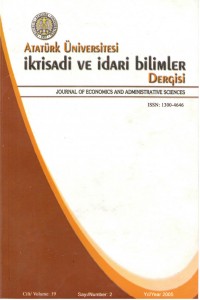Yıl 2005,
Cilt: 19 Sayı: 2, 49 - 58, 27.11.2010
Öz
Bu makale, beşeri sermaye ile büyüme ilişkisini Türkiye
açısından, Johansen ko-entegrasyon yöntemini kullanarak test etmektedir.
Eğitimli insanların üretim sürecine olan olumlu katkısı, makalenin temel
varsayımını oluşturmaktadır. Yapılan Ko-entegrasyon testinin sonuçlarına göre,
beşeri sermaye ile büyüme arasında uzun dönemli bir ilişki mevcuttur. Öte
yandan Granger nedensellik testi, büyümeden beşeri sermayeye tek yönlü bir
nedensellik ilişkisini göstermektedir.
Anahtar Kelimeler
Kaynakça
- Asteriou, Dimitrious ve Agiomirgianakis G. (2001), “Human Capital and Economic Growth, Time Series Evidence from Greeca,” Journal of Policy Modelling, 23, ss.481 489.
- Barro, R.J. (1991), “Economic Growth in a Cross Section of Countries,” Quarterly Journal of Economics, 56, ss.407 443.
- Becker, G., Murphy, K. ve Tamura, R. (1990), “Human Capital, Fertility and Economic Growth,” Journal of Political Economy, 98, ss.12 37.
- Canpolat, N. (2000), “Türkiye’de Be eri Sermaye Birikimi ve Ekonomik Büyüme,” H.Ü. BF. Dergisi, ss.265 281.
- Çoban, O. (2004), “Be eri Sermayenin Büyüme Üzerine Etkisi: Türkiye Örne i,” .Ü. SBF Dergisi, 30, ss.133 141.
- Dickey, D.A. ve Fuller W.A. (1979), “Distributions of the Estimators for Autoregressive Time Series with a Unit Root,” Journal of American Statistical Association, 74, ss.427 431.
- D E (2003), 2002 Türkiye statistik Yıllı ı, Ankara.
- Enders, W. (1995), Applied Econometric Time Series, John Wiley and Sons, New York.
- Engle, R. ve Granger, C.W.J. (1987), “Cointegration and Error-Correction: Representation, Estimation, and Testing,” Econometrica, 55, ss.251 276.
- Granger, C.W.J. (1988), “Some Recent Developments in the Consept of Causality,” Journal of Econometrics, 39, ss. 199 211.
- Johansen, S. (1988), “Statistical Analysis of Cointegrating Vectors,” Journal of Economic Dynamics and Control, 12, ss.231 254.
- Kar, M. (2003), “Türkiye’de Be eri Sermaye ve Ekonomik Büyüme: Nedensellik Testi,” II. Ulusal Bilgi, Ekonomi ve Yönetim Kongresi Bildiriler Kitabı, zmit, ss.181 192.
- Kim, Y.J. ve Lee J.W. (1999), “Technological Change, Investment in Human Capital, and Economic Growth,” CID Working Papers, 29, ss. 1 40.
- Lucas, R.E. (1998), “On the Mechanics of Economic Development,” Journal of Monetary Economics, ss. 3 42.
- Mankiw, G., Romer, D. ve Weil, D.N. (1992), “A Contribution to the Empirics of Economic Growth,” The Quarterly Journal of Economics, ss. 407 437.
- Mosino, A. (2002), “Education, Human Capital Accumulation and Economic Growth”, Lousanne: University of Lousanne epartment of Econometrics (www.hec.unil.ch/modmacro/recueil/Mosino.pdf). and Political Economics”,
- Psacharopoulos, G. (1985), “Returns of Education: A Further International Update and Implications” The Journal of Human Resources, 20/4, ss. 583-604.
- Psacharopoulos, G. Ve Patrinos H. A. (2002), “Returns to Investment in Education: A Further Update”, World Bank Policy Research Working Paper 2881, September.
- Solow, R. (1956), “ A Contrubution to the Theory of Economic Growth,” Quarterly Journal of Economics, LXX, s.65-94.
Yıl 2005,
Cilt: 19 Sayı: 2, 49 - 58, 27.11.2010
Öz
Kaynakça
- Asteriou, Dimitrious ve Agiomirgianakis G. (2001), “Human Capital and Economic Growth, Time Series Evidence from Greeca,” Journal of Policy Modelling, 23, ss.481 489.
- Barro, R.J. (1991), “Economic Growth in a Cross Section of Countries,” Quarterly Journal of Economics, 56, ss.407 443.
- Becker, G., Murphy, K. ve Tamura, R. (1990), “Human Capital, Fertility and Economic Growth,” Journal of Political Economy, 98, ss.12 37.
- Canpolat, N. (2000), “Türkiye’de Be eri Sermaye Birikimi ve Ekonomik Büyüme,” H.Ü. BF. Dergisi, ss.265 281.
- Çoban, O. (2004), “Be eri Sermayenin Büyüme Üzerine Etkisi: Türkiye Örne i,” .Ü. SBF Dergisi, 30, ss.133 141.
- Dickey, D.A. ve Fuller W.A. (1979), “Distributions of the Estimators for Autoregressive Time Series with a Unit Root,” Journal of American Statistical Association, 74, ss.427 431.
- D E (2003), 2002 Türkiye statistik Yıllı ı, Ankara.
- Enders, W. (1995), Applied Econometric Time Series, John Wiley and Sons, New York.
- Engle, R. ve Granger, C.W.J. (1987), “Cointegration and Error-Correction: Representation, Estimation, and Testing,” Econometrica, 55, ss.251 276.
- Granger, C.W.J. (1988), “Some Recent Developments in the Consept of Causality,” Journal of Econometrics, 39, ss. 199 211.
- Johansen, S. (1988), “Statistical Analysis of Cointegrating Vectors,” Journal of Economic Dynamics and Control, 12, ss.231 254.
- Kar, M. (2003), “Türkiye’de Be eri Sermaye ve Ekonomik Büyüme: Nedensellik Testi,” II. Ulusal Bilgi, Ekonomi ve Yönetim Kongresi Bildiriler Kitabı, zmit, ss.181 192.
- Kim, Y.J. ve Lee J.W. (1999), “Technological Change, Investment in Human Capital, and Economic Growth,” CID Working Papers, 29, ss. 1 40.
- Lucas, R.E. (1998), “On the Mechanics of Economic Development,” Journal of Monetary Economics, ss. 3 42.
- Mankiw, G., Romer, D. ve Weil, D.N. (1992), “A Contribution to the Empirics of Economic Growth,” The Quarterly Journal of Economics, ss. 407 437.
- Mosino, A. (2002), “Education, Human Capital Accumulation and Economic Growth”, Lousanne: University of Lousanne epartment of Econometrics (www.hec.unil.ch/modmacro/recueil/Mosino.pdf). and Political Economics”,
- Psacharopoulos, G. (1985), “Returns of Education: A Further International Update and Implications” The Journal of Human Resources, 20/4, ss. 583-604.
- Psacharopoulos, G. Ve Patrinos H. A. (2002), “Returns to Investment in Education: A Further Update”, World Bank Policy Research Working Paper 2881, September.
- Solow, R. (1956), “ A Contrubution to the Theory of Economic Growth,” Quarterly Journal of Economics, LXX, s.65-94.
Toplam 19 adet kaynakça vardır.
Ayrıntılar
| Birincil Dil | tr;en |
|---|---|
| Bölüm | Makaleler |
| Yazarlar | |
| Yayımlanma Tarihi | 27 Kasım 2010 |
| Yayımlandığı Sayı | Yıl 2005 Cilt: 19 Sayı: 2 |





